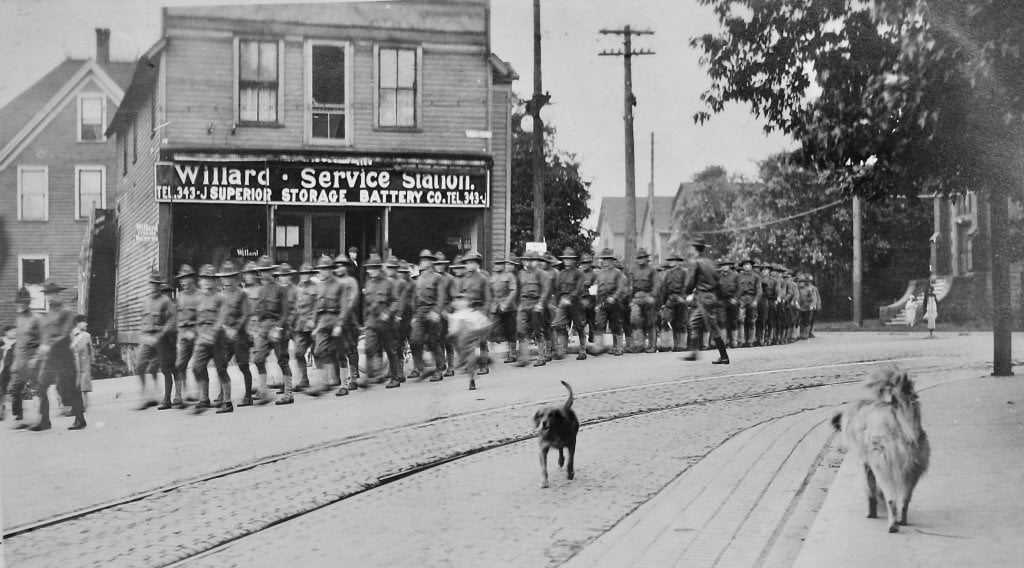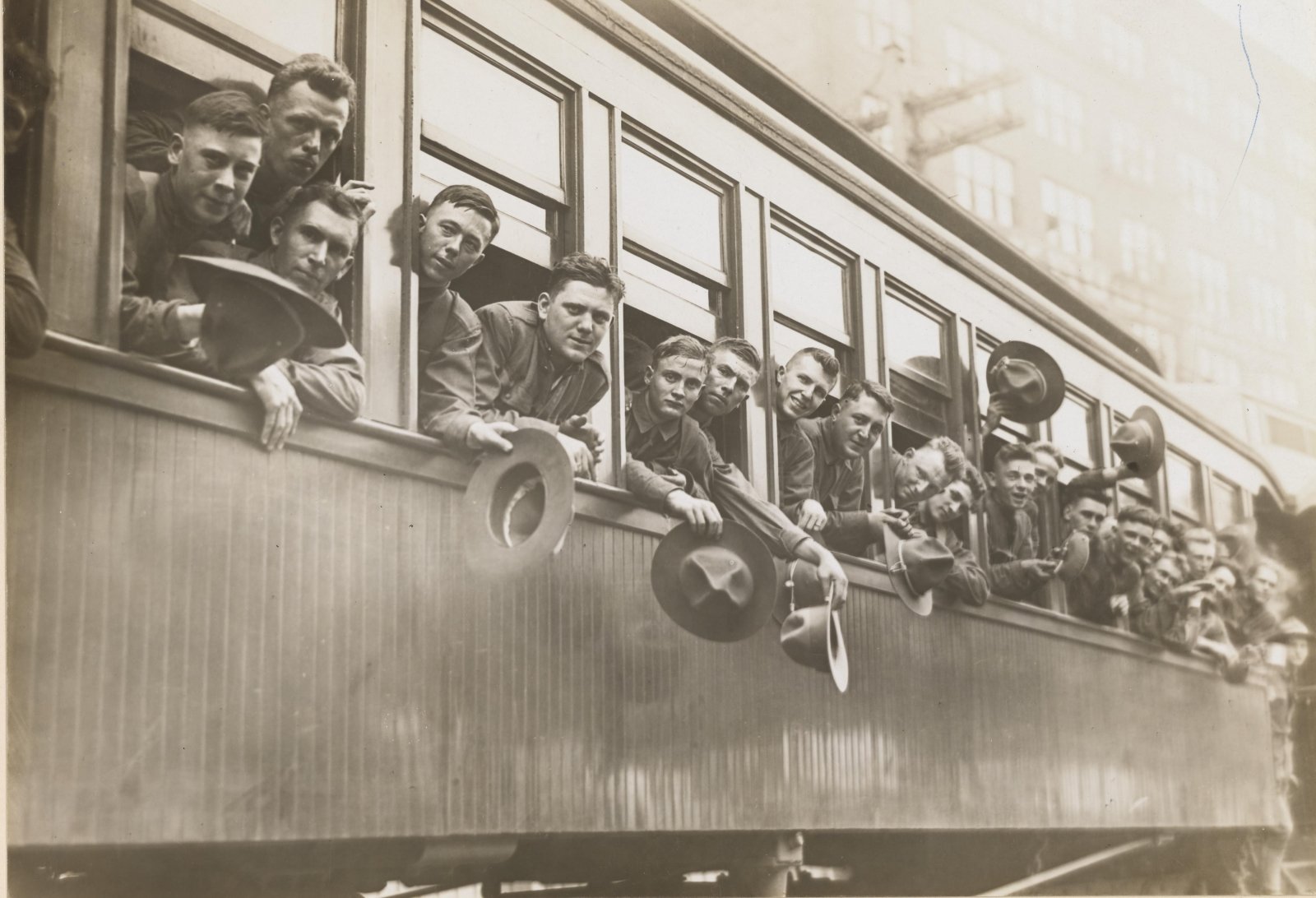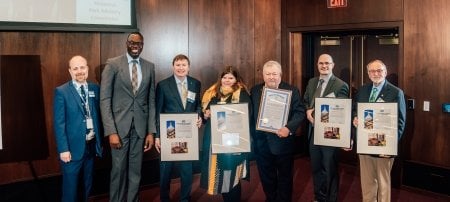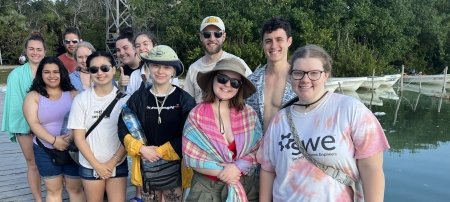A Michigan Technological University researcher discovers a dispatch that details troop training on campus in August 1918.
Researcher and military historian Steven Walton oversaw the design and construction of the replica firing trench on campus, built this fall as part of the World War I & the Copper Country project to mark a century since the end of the Great War. But his biggest excavation for the project didn’t require sandbags or shovels. Walton, an associate professor of history in the Department of Social Sciences, unearthed a 15-page report at the National Archives in Washington, D.C. that offers new, detailed information on Michigan Tech’s role in World War I—specifically the activities for the Committee on Education and Special Training (CEST).
CEST was set up for immediate specialized vocational training across the nation, in things like carpentry, mining, and even dentistry, Walton explains, noting that agency predates establishment of the Student Army Training Corps (SATC, the forerunner of ROTC), which was established on campus in fall semester 1918.
A Michigan College of Mines rarity is discovered.
The report is buried deep in Record Group 165 at the National Archives, which covers all activities of the Records of the War Department General and Special Staffs during WWI. Walton dubbed it the “Houle Report” for obvious reasons: It was written by Professor Albert J. Houle, who, at the request of then-president F.W. McNair, supervised a military-mining training course run by 10 instructors from the University then known as the Michigan College of Mines.
"I was looking in the various record groups for Army training and luckily, the subsection for the Organization and Training Division (G-3) is organized by state, so I just had them pull the two boxes for Michigan and there were two folders for the Michigan College of Mines (MCM)," says Walton. "Most of the papers in there were weekly reports of numbers of men in ‘camp,’ their fitness, the quality of the food and so on. And for one weekly report, Houle sent not only the standardized two-page form, but this 15-page report with photos pasted in."
"Given the record-keeping culture of the military, I knew there would be records of MCM’s activities during the war, but finding a typed report with photos was surprising."
The training was developed in response to an April 1918 nationwide U.S. Army Corps of Engineers request for 600 men trained in mining and air drill running. McNair, a strong supporter of the war effort, went to the Capital to hammer out the details.
When the U.S. Army officer who inspected the potential training site at the end of April was asked on the standardized form: 'Do they have a clear conception of what is wanted (in terms of training)?' his response was, 'Yes, much clearer than I have myself'," says Walton. The officer added, "In my opinion the conditions at the Michigan College of Mines are as near ideal as can be found. The only serious problem with which they have to deal is that of finding a competent chef.” A contract was secured to train 600 troops in 200-man, two-month training blocks.
"There was nothing like it in the folders for some of the other schools’ reports in those boxes," Walton says. "There is also a letter from the CEST Director of the War Aims Course that indicated there was another illustrated report that Houle sent at the end of July, but it has not apparently survived.”
A little-known aspect of Tech history comes to light.
Houle’s typewritten report to CEST in Washington, D.C., dated August 15, 1918, contains dozens of photos and details the final week of training for the first detachment sent to train at the University.
"Second to the military work, the mine rescue work would be judged to be the most popular. We have some excellent pictures this week to illustrate our efforts in this direction."
“Our work with the first detachment, a review of period of instruction coupled with observations of the character of the practical mining work which the boys can undoubtedly do, as the accompanying pictures show, gives us the right to conclude that the time and money has been well spent,” Houle wrote.
"We are confident that the army organization which receives the men who have been trained at this camp will be well served by the product of this institution an of this celebrated mining district."
“Often it is the task of a historian to reconstruct a narrative from things like weekly reports, which can be done and is often quite fascinating to see, but a snapshot like this, with photos as well, is a rare glimpse at a moment in time," says Walton. "The CEST published a report of its work in 1918, before much of its work was merged into the SATC. There you just get the nation-wide overview, although with three pictures from MCM, suggesting we were a model college for them). Houle’s report rounds out that picture.”
Reports were issued weekly, detailing the students’ drill regimen six days a week from 7 a.m. to 4:30 p.m., with an hour for lunch. Recreation hours were 6 to 10 p.m. in the gymnasium and clubhouse (the current ROTC building). Excerpts from the report shed light on the interconnection of the University, copper mining companies and the community.
There was drilling. And there was drilling.
Student soldiers learned the care and operation of drill mechanisms, and how to place and blast in the practice mine, a tunnel dug into the hillside behind campus, near the bottom of the hill of Phoenix Drive next to the present-day Husky Motors. They also received military instruction, including bayonet and gas mask practice, and marched in close-order drills.

“As an indication of the variety of work which we seek to enliven the course, the above picture shows the boys at work in the preparation of a tunnel set after the necessary dirt has been removed,” Houle wrote. (National Archives photo)




Mine tours, Armory lunch, and lemonade in Lake Linden.

The 553rd State Troops hosted the detachment for lunch at the Calumet Armory during the mine tour. And received a thanks, to the tune of “The Old Gray Mare,” for the hospitality. (National Archives photo)
The detachment took streetcars to the Village of Calumet one foggy morning on a day-long tour of area mining operations.
“From the Red Jacket shaft, we proceeded to the Tamarack No. 5 Shaft, which, like the Red Jacket is hoisting from a depth of over one mile perpendicularly, and there we saw a hoist of an entirely different character,” Houle wrote.
“Since by this time it was approaching noon and hunger was becoming quite manifest, we turned back toward Calumet, passing along 7th Street, Red Jacket, in platoon formation.”
The battalion passed through Laurium and boarded street cars for Lake Linden, marching through the village to the mills.
“As we emerged from the doorway of the last building in the plant, the leaching house, we were met by a delegation of Lake Linden women. They gave the boys unlimited quantities of lemonade,” Houle reported.

“We feel quite as proud and sure of their underground capacity as we do of their military appearance, and our confidence in their ability to give an extra good account of themselves along any of these lines is firmly established,” Houle wrote.
The inspection reports in the National Archives run from June through November 1918, says Walton. A Nov. 13 telegram from MCM to the War Department indicates 200 men were detailed to the third session of mine running. But it didn't begin due to the influenza outbreak—the “Spanish flu” pandemic that had erupted in training camps late the previous year and killed more than 50 million people worldwide.
"The college and community had been clear at the end of September. And that telegram was of course sent two days after the Armistice was signed," says Walton. "By that time all the students who had already been engineering reservists were transferred to the new SATC, and it would appear the campus concentrated its training on less vocational aspects for our 335 cadets by the end of the year."
Michigan Technological University is an R1 public research university founded in 1885 in Houghton, and is home to nearly 7,500 students from more than 60 countries around the world. Consistently ranked among the best universities in the country for return on investment, Michigan's flagship technological university offers more than 185 undergraduate and graduate degree programs in science and technology, engineering, computing, forestry, business, health professions, humanities, mathematics, social sciences, and the arts. The rural campus is situated just miles from Lake Superior in Michigan's Upper Peninsula, offering year-round opportunities for outdoor adventure.







Comments